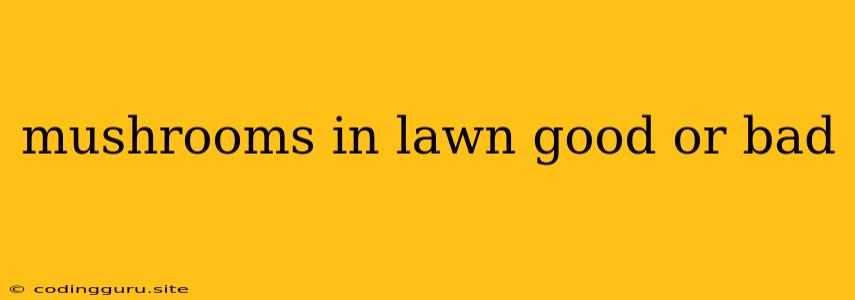Are Mushrooms in Your Lawn Good or Bad?
Have you ever noticed strange-looking fungi popping up in your lawn? Those are mushrooms, and while they might look interesting, you might wonder if they're good or bad for your grass. Let's delve into the world of lawn mushrooms and learn how to address them.
Understanding Mushrooms in Your Lawn
Mushrooms are the fruiting bodies of fungi, which live underground in a vast network of threads called mycelium. The appearance of mushrooms in your lawn is simply a sign that the fungus is thriving and reproducing.
Are Mushrooms Harmful to Your Grass?
Generally, mushrooms don't directly harm your lawn. However, their presence can be a symptom of underlying issues in your soil, which could ultimately affect your grass's health.
Here's a breakdown:
Mushrooms thrive in moist, shady environments with plenty of organic matter. If your lawn has compacted soil, poor drainage, or excessive thatch, it creates an ideal environment for fungal growth.
However, mushrooms can be a sign of a healthy ecosystem too. If you have just a few mushrooms appearing occasionally, it may not be a cause for concern.
When Mushrooms Are a Problem
While mushrooms are usually harmless, they can be a nuisance in certain situations.
- Allergic Reactions: Some people are allergic to certain types of mushrooms, and coming into contact with them can cause skin irritation or respiratory issues.
- Aesthetic Appeal: Mushrooms can make your lawn look unsightly, especially if they appear in large numbers.
- Harmful Species: Although rare, some mushrooms can be poisonous to pets or children if ingested. If you have young children or pets, it's best to remove any mushrooms you find.
Tips to Control Mushrooms in Your Lawn
If you're bothered by mushrooms, here are some tips to control their growth:
- Improve Drainage: Ensure your lawn has proper drainage. If your soil is compacted, aerate it regularly to allow water to flow through.
- Reduce Thatch: Thatch is a layer of dead grass and organic matter that can build up on your lawn. Regularly dethatch your lawn to prevent this buildup.
- Water Deeply and Less Often: Avoid frequent, shallow watering. Instead, water deeply once or twice a week to promote a healthy root system and discourage fungal growth.
- Remove Organic Matter: Remove leaves, branches, and other organic matter that can decompose and provide food for mushrooms.
- Apply Fungicide: In severe cases, you can apply a fungicide to kill the fungus. However, this is a temporary solution, and the mushrooms may reappear if the underlying issues aren't addressed.
- Light: Mushrooms often thrive in shady areas, so try to increase sunlight exposure in your lawn.
Identifying the Mushroom Type
Knowing the type of mushroom you have can help determine the best course of action. If you're unsure, consult a local mycologist or agricultural extension office for identification.
Conclusion
Mushrooms in your lawn are usually not a major cause for concern. Their presence often indicates healthy soil with abundant organic matter. However, if they become a nuisance or you suspect harmful species, address the underlying issues in your lawn to discourage their growth. Remember, a healthy lawn is the best defense against unwanted mushrooms.
